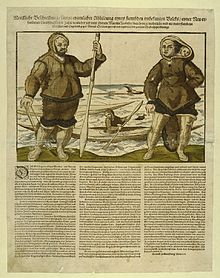Edward Dodding
Dr Edward Dodding FRCP | |
|---|---|
| Born | c. 1540 Westmorland, England |
| Died | April 1592 (aged 51–52) |
| Nationality | English |
| Education | Trinity College, Cambridge |
| Years active | 1572–1592 |
| Known for | Post-mortem of Kalicho |
| Medical career | |
| Profession | Physician |
Edward Dodding (c. 1540 – April 1592) was an English physician who completed the post-mortem examination of Kalicho, one of three Inuit who died soon after they were brought to England by Martin Frobisher in 1577. His post-mortem notes on Kalicho are unusually detailed for their time and provide insights into contemporary medical knowledge and the attitudes of the English towards indigenous people.
Early life
Dodding was born around 1540 in the historic county of Westmorland, England. He was educated at Trinity College, University of Cambridge,[1] of which he became a fellow, and was awarded his BA in 1562 or 1563 and his MA in 1566.[1][2]
Career
Dodding was granted a licence to practise physic by the University of Cambridge in 1573, and was created M.D. in 1576. In the following year he appears to have been in practice at Bristol. He was admitted a fellow of the College of Physicians on 25 June 1584[2] and practiced medicine until his death in 1592.[1]
Kalicho, Arnaq, and Nutaaq

After Kalicho became unwell, Dodding initially advised bloodletting in order to quench "the fire of the inflammation" but this was refused by Kalicho. In the last hour of Kalicho's life, Dodding observed that his speech, appetite and pulse all declined but near the end he began to talk fairly lucidly again and sang a song that had been heard when he was first removed from Baffin Island. His last words were a phrase that he had learned in England, "God be with you" and then, on 7 November 1577, about one month after his arrival in England, he died.[6]
A post-mortem examination of Kalicho was performed by Dodding in Bristol on the day of Kalicho's death. He noted broken
Dodding insisted that Arnaq watch Kalicho's burial at
Dodding's notes, which have been corroborated from paintings of the captives and contemporary accounts, provide insights into medical knowledge and practice in the sixteenth century and the attitudes of the English to indigenous people,[9] but his personal attitude to the three captives is unclear. He was well trained and does not appear to have been cruel or callous but after Kalicho died, he expressed regret not at the man's death, but at the loss for the second time of the opportunity for Queen Elizabeth to see the captured people.[7][10]
Death
Dodding was buried at St Dunstan-in-the-West in Fleet Street, London, on 11 April 1592.[2]
References
- ^ a b c "DODDING, Edward". British History Online. Retrieved 28 November 2017.
- ^ a b c Munk's Roll: Volume I: Edward Dodding. Lives of the Fellows, Royal College of Physicians. Retrieved 28 November 2017.
- ^ A male had also been taken to England after Frobisher's first voyage making the number he took to England four.
- ^ 1906,0509.1.29. British Museum. Retrieved 28 November 2017.
- ^ 1906,0509.1.30. British Museum. Retrieved 28 November 2017.
- ^ ISBN 978-0-521-86594-4.
- ^ ISBN 978-0-230-61189-4.
- ^ Dodding, Edward. "1577: The Death of an Inuit Man in England" (PDF). National Humanities Center. Retrieved 27 November 2017.
- ^ Cheshire, Neil; Aldron, Tony; Quinn, Alison; Quinn, David. "Frobisher's Eskimos in England". nationalhumanitiescenter.org: 23–50.
- ISBN 0-8032-6897-1.
